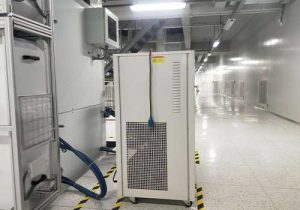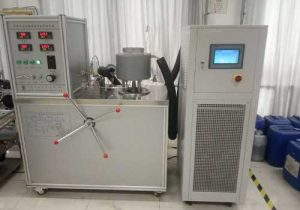glycol tank chiller
Working Principles of Glycol Tank Chillers
The operation of a glycol tank chiller is based on the principles of heat transfer and the unique properties of glycol – water mixtures. Glycol, typically ethylene glycol or propylene glycol, is mixed with water to create a coolant with a lower freezing point than pure water. This property makes it ideal for applications where the risk of freezing needs to be minimized, especially in low – temperature environments.

The chiller system consists of several key components that work together to facilitate the cooling process. The glycol solution is stored in a reservoir or directly within the tank that needs to be cooled. A pump circulates the glycol through a closed – loop system. As the glycol passes through the heat exchanger within the chiller unit, it absorbs heat from the tank. The refrigerant within the chiller, operating on the vapor – compression cycle, then absorbs the heat from the glycol, cooling it down. The cooled glycol is then pumped back into the tank, where it continues to absorb heat, maintaining the desired temperature inside the tank.
The heat absorbed by the refrigerant is rejected to the environment. In air – cooled glycol tank chillers, fans blow air over the condenser coils, dissipating the heat into the surrounding air. In water – cooled versions, a secondary water loop, often connected to a cooling tower, is used to carry away the heat from the condenser. This continuous cycle of heat absorption, transfer, and rejection allows the glycol tank chiller to maintain a stable and controlled temperature within the tank.
Components of Glycol Tank Chillers
Glycol Tank
The glycol tank is where the glycol – water mixture is stored or where the liquid or material to be cooled is held. It is typically made of materials such as stainless steel, which offers excellent corrosion resistance, especially when in contact with glycol solutions. The tank may be equipped with insulation to minimize heat transfer from the outside environment, helping to maintain the desired temperature more efficiently. Additionally, it often has sensors for monitoring temperature, level, and sometimes the glycol concentration within the tank.
Chiller Unit
The chiller unit is the heart of the system. It contains the components necessary for the refrigeration cycle, including the compressor, condenser, evaporator, and expansion valve. The compressor raises the pressure and temperature of the refrigerant, which then flows to the condenser. In the condenser, the refrigerant releases heat to the environment (either through air or water cooling). The cooled and condensed refrigerant then passes through the expansion valve, where its pressure drops, causing it to cool further. Finally, the cold refrigerant enters the evaporator, where it absorbs heat from the glycol solution, completing the cycle.

Pump
The pump is responsible for circulating the glycol solution through the system. It ensures a continuous flow of glycol, which is essential for effective heat transfer. Centrifugal pumps are commonly used in glycol tank chiller systems due to their ability to handle large volumes of fluid and maintain a consistent flow rate. The pump’s capacity is carefully selected based on the size of the tank, the required cooling capacity, and the length of the piping in the system.
Heat Exchanger
The heat exchanger in the chiller unit is where the heat transfer between the glycol and the refrigerant occurs. There are different types of heat exchangers, such as shell – and – tube and plate – and – frame heat exchangers, each with its own advantages in terms of heat transfer efficiency, compactness, and ease of maintenance. The design of the heat exchanger is crucial as it directly affects the overall performance of the chiller, determining how effectively heat can be transferred from the glycol to the refrigerant.
Control System
Modern glycol tank chillers are equipped with sophisticated control systems. These systems monitor and regulate various parameters, including the temperature of the glycol in the tank, the refrigerant pressure and temperature, and the flow rate of the glycol. They use sensors, controllers, and actuators to maintain the desired operating conditions. For example, if the tank temperature rises above a set point, the control system can increase the speed of the pump or adjust the operation of the chiller unit to enhance cooling.
Applications of Glycol Tank Chillers
Food and Beverage Industry
In the food and beverage sector, glycol tank chillers are used for a variety of applications. They are employed to cool and store ingredients, such as dairy products, juices, and syrups, ensuring their freshness and quality. In breweries, glycol – cooled tanks are used for fermenting and conditioning beer, maintaining the precise temperature required for different stages of the brewing process. This helps to control yeast activity, flavor development, and carbonation, resulting in a consistent and high – quality product. Similarly, in wineries, glycol tank chillers are used to cool grape must during fermentation and to store wine at the optimal temperature to prevent spoilage and preserve its flavor and aroma.
Pharmaceutical Manufacturing
The pharmaceutical industry requires strict temperature control for the storage of raw materials, active pharmaceutical ingredients (APIs), and finished products. Glycol tank chillers are used to maintain the cold chain, ensuring that drugs and vaccines remain stable and effective. They are used in laboratories for cooling reaction vessels, storage of biological samples, and in manufacturing facilities for the production of temperature – sensitive medications. The ability of glycol – based coolants to operate at low temperatures without freezing makes them ideal for these applications, where even a slight temperature deviation can compromise the integrity of the products.
Industrial Processes
In various industrial processes, glycol tank chillers are used to cool equipment, machinery, and process fluids. For example, in metalworking operations, such as machining and casting, glycol – cooled systems are used to cool cutting tools, dies, and molds. This helps to prevent overheating, extend the lifespan of the tools and equipment, and improve the quality of the finished products. In chemical plants, glycol tank chillers are used to control the temperature of reactors, distillation columns, and other process vessels, ensuring the safety and efficiency of chemical reactions. They are also used in the plastics industry for cooling injection molds, reducing cycle times and improving the productivity of plastic manufacturing processes.

HVAC Systems
Glycol tank chillers can also be integrated into heating, ventilation, and air – conditioning (HVAC) systems, especially in cold climates. In these systems, glycol – water mixtures are used as the coolant in closed – loop systems to prevent freezing of the pipes. The chiller cools the glycol, which is then circulated through the building’s heating and cooling coils. This allows for efficient temperature control while providing freeze protection, ensuring that the HVAC system operates reliably even in sub – zero temperatures.
Advantages of Glycol Tank Chillers
Freeze Protection
One of the primary advantages of glycol tank chillers is their ability to provide excellent freeze protection. The glycol – water mixture has a lower freezing point than pure water, allowing the chiller to operate effectively in low – temperature environments without the risk of the coolant freezing and damaging the system. This is particularly important in industries where continuous cooling is required, even in cold climates or during winter months.
Thermal Stability
Glycol has good thermal stability, meaning it can absorb and release heat efficiently without significant changes in its physical properties over a wide range of temperatures. This property ensures consistent and reliable cooling performance, as the glycol can effectively transfer heat from the tank to the chiller unit, maintaining the desired temperature within the tank.
Corrosion Resistance
When properly formulated and maintained, glycol – water mixtures can offer good corrosion resistance. The addition of corrosion inhibitors to the glycol solution helps to protect the metal components of the chiller system, such as pipes, pumps, and heat exchangers, from rust and corrosion. This extends the lifespan of the equipment and reduces maintenance costs associated with replacing corroded parts.
Precise Temperature Control
Glycol tank chillers, with their advanced control systems, can provide precise temperature control. This is crucial in industries where even small temperature fluctuations can affect product quality or process efficiency. The ability to maintain a stable temperature within the tank ensures that the stored materials or the ongoing processes remain within the optimal temperature range, leading to better product outcomes and reduced waste.
Maintenance Requirements of Glycol Tank Chillers
Glycol Concentration Checks
Regularly checking the glycol concentration in the system is essential. Over time, the glycol – water mixture can become diluted due to evaporation, leaks, or the addition of water for various reasons. A lower glycol concentration can increase the risk of freezing and reduce the overall performance of the chiller. Using a refractometer or other appropriate testing methods, the glycol concentration should be monitored and adjusted as needed to maintain the recommended level, typically between 30% – 50% depending on the application and the expected lowest temperature.
Component Inspection
All components of the glycol tank chiller system, including the pump, heat exchanger, compressor, and condenser, should be inspected regularly. Look for signs of wear, leaks, or damage. For example, check the pump for abnormal vibrations or noises, which could indicate a problem with the bearings or impeller. Inspect the heat exchanger for fouling, corrosion, or reduced heat transfer efficiency. Regular maintenance of these components can prevent breakdowns and ensure the long – term reliability of the chiller.
Refrigerant System Checks
If the chiller uses a refrigerant, the refrigerant system should be checked for proper pressure, temperature, and refrigerant levels. Leaks in the refrigerant system can reduce the cooling capacity of the chiller and may also pose environmental and safety risks. A qualified technician should perform regular refrigerant system inspections, including leak detection and refrigerant recharge if necessary.
Cleaning and Flushing
Periodically, the glycol system should be cleaned and flushed to remove any dirt, debris, or contaminants that may have accumulated over time. This helps to maintain good heat transfer efficiency and prevent clogging of the pipes and components. Cleaning may involve using chemical cleaners specifically designed for glycol systems, followed by thorough flushing with clean water and refilling with the appropriate glycol – water mixture.
In conclusion, glycol tank chillers are versatile and essential cooling systems in many industries. Their unique properties, such as freeze protection, thermal stability, and corrosion resistance, make them suitable for a wide range of applications where precise temperature control is required. By understanding their working principles, components, applications, advantages, and maintenance requirements, industries can effectively utilize glycol tank chillers to optimize their cooling processes, ensure product quality, and enhance overall operational efficiency.
Related recommendations
Precautions for the Use of Small Chiller Systems
1451Precautions for the Use of Small Chiller Systems With the rapid development of refrigeration equipment, small chillers have gradually become popular. The function of the small chiller is to ...
View detailswater cooling system
621Water Cooling Systems: An In-Depth Analysis Definition of Water Cooling SystemsWater cooling systems, also known as liquid cooling systems, are methods used to lower the temperature of various ...
View detailshot water bath equipment
323I. Introduction to Hot Water Bath EquipmentHot water bath equipment is an essential component of modern households and commercial establishments, providing comfort and convenience by ensuring a s...
View detailsBattery Pack Test Chillers
1278Battery Pack Test Chillers The battery pack test chiller is a water cooling device that can provide constant temperature, constant current and constant pressure. The operation of the battery...
View details
 LNEYA Chiller
LNEYA Chiller






HelloPlease log in